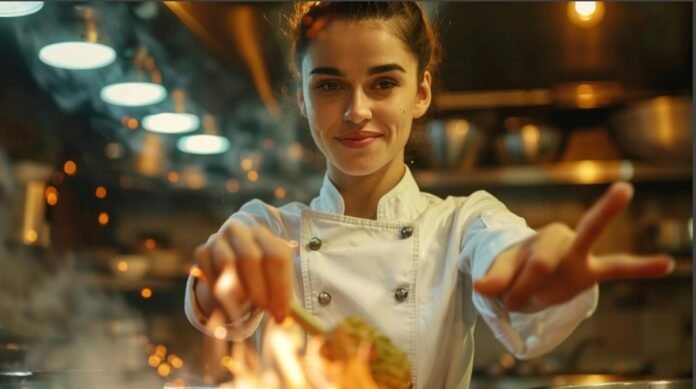Aryn Hala is a renowned chef from Gold Coast, Queensland, Australia, celebrated for her innovative and sustainable approach to cooking. Born on April 12, 1988, Aryn’s love for the culinary arts was sparked in her grandmother’s kitchen, where she learned the value of fresh, local ingredients and traditional cooking methods. This early passion led her to the Culinary Institute of Australia in Sydney, where she earned a diploma in Culinary Arts and co-founded the Sustainable Cooking Club, fostering her commitment to eco-friendly cooking.
After completing her formal education, Aryn returned to Gold Coast and began her professional career at Oceanside Seafood as a sous chef. Her innovative use of local produce and dedication to sustainability quickly earned her recognition, setting new standards for environmental stewardship in the culinary industry. In November 2021, Aryn took on the role of head chef at Patio Season, a modern Australian restaurant known for its al fresco dining and seasonal menus. Here, she focuses on dishes that showcase the freshest local produce, supported by her in-house herb garden.
Aryn’s culinary philosophy emphasizes ethical sourcing, creativity, and community engagement. Beyond the kitchen, she is a passionate advocate for sustainable practices, participating in community-based conservation efforts and mentoring the next generation of chefs. Aryn is currently working on a cookbook that shares her favorite recipes and tips for sustainable cooking, aiming to inspire others to make environmentally conscious choices. Her approach to cooking combines passion, creativity, and a deep respect for the environment, making her a respected figure in the culinary world.
What sparked your interest in cooking when you were young?
My love for cooking began in my grandmother’s kitchen when I was around eight years old. I remember spending weekends at her house, where she would always be preparing something delicious. One Saturday morning, she asked me to help her make her famous apple pie. I was tasked with peeling the apples and mixing the dough. As I watched her expertly roll out the crust, she shared stories about how she learned to cook from her own mother. That connection to family and tradition resonated with me deeply. I loved the feeling of creating something from scratch and the joy it brought to those around us.
How do you recommend getting young people interested in cooking?
The key is to make cooking fun and accessible. I’ve found that kids love getting their hands messy, so involving them in activities like kneading dough or shaping meatballs is a great way to start. It’s also important to let them have a say in what they’re making. For example, when my niece, Emma, was visiting, we created a “DIY Pizza Night.” We laid out various toppings like cheese, tomatoes, peppers, and pineapple, and she loved crafting her own pizza. It was a fun, interactive way to introduce her to cooking, and she felt a sense of pride in her creation.
Do you have any memorable experiences teaching young people to cook?
Absolutely! One of my favorite experiences was running a cooking class for local school kids. We called it “Junior Chef Day.” I decided to teach them how to make simple veggie stir-fry using fresh, local ingredients. I remember one little boy, Jake, who was initially hesitant about eating vegetables. But once he learned to chop carrots and toss them in the wok, he was eager to taste his creation. Seeing his face light up when he tasted the dish and exclaimed, “I actually like veggies!” was incredibly rewarding. It reminded me of how impactful these early experiences can be in shaping food preferences and encouraging healthier eating habits.
What role do you think storytelling plays in getting young people excited about cooking?
Storytelling is a powerful tool for engaging young minds. It adds a layer of magic to the cooking process. When I was a child, my grandmother would tell me tales of how she would forage for wild herbs with her siblings. She spoke of the vibrant colors and distinct flavors of the plants they would find. When teaching kids, I often share stories about the origins of the ingredients we’re using. For instance, I might talk about how honey is made or the journey of cocoa beans from tree to chocolate. These stories create a sense of wonder and curiosity, encouraging kids to see cooking as more than just a chore—it becomes an adventure.
How do you incorporate creativity in cooking to inspire young people?
Creativity is essential. I encourage kids to think of cooking as an art form. We often have “colorful food challenges” where they must use as many colors as possible in their dishes. Once, during a summer cooking camp, I gave the kids an array of fruits, vegetables, and herbs, and asked them to create a dish inspired by a rainbow. The results were amazing! One girl made a fruit salad with strawberries, oranges, kiwis, blueberries, and grapes, arranging them in a beautiful spiral. This not only taught them about healthy eating but also allowed them to express themselves creatively. It’s amazing how a little bit of imagination can transform a simple dish into something extraordinary.
How do you deal with mistakes in the kitchen with young cooks?
Mistakes are part of the learning process, and I always emphasize that to young cooks. I remember a time when my younger brother, Liam, and I tried to make chocolate chip cookies, but we accidentally used salt instead of sugar. We ended up with a salty mess, but it turned into a lesson about measuring ingredients carefully. We laughed about it and decided to make a second batch together, which turned out perfectly. I tell kids that it’s okay to make mistakes in the kitchen. It’s all about learning and having fun. The kitchen should be a space where they feel safe to experiment without fear of failure.
What was the first dish you successfully cooked on your own as a child?
The first dish I successfully cooked on my own was scrambled eggs. I remember waking up early one Saturday morning when I was about nine years old. My parents were still asleep, and I decided to surprise them with breakfast. I carefully cracked the eggs into a bowl, added a splash of milk, and whisked them with a fork, just like my mom had shown me. I heated up a pan, poured in the mixture, and slowly stirred the eggs as they cooked. When I served them on a plate with a sprig of parsley from the garden, I felt incredibly proud. Seeing the look of surprise and delight on my parents’ faces made me realize how food can bring joy to others. That simple dish was a small victory that fueled my confidence and curiosity in the kitchen.
How can parents encourage their kids to try cooking even if they’re not interested at first?
Sometimes, kids aren’t interested in cooking because they see it as a chore. One way to change that perspective is to make cooking a fun and interactive experience. For example, you can have a “kitchen adventure day” where you pretend to be chefs on a cooking show or explorers discovering new ingredients. When my cousin, Sam, was reluctant to help in the kitchen, I introduced him to a game where we had to cook a meal using ingredients that started with the same letter as our names. It turned cooking into a playful activity and piqued his interest. Involving kids in the shopping process, letting them pick out ingredients, and giving them choices in what they cook can also boost their enthusiasm. It’s all about making them feel involved and excited about the process.
How do you make sure cooking is safe for young children?
Safety is a top priority, especially when kids are involved. I always start by setting some ground rules, like washing hands before handling food and being careful around sharp objects and hot surfaces. When I was teaching my little brother to cook, I made sure to explain each step clearly and supervise him closely. We practiced using a butter knife on soft ingredients like bananas before moving on to sharper tools. For tasks like chopping, I recommend using a child-friendly knife and showing them the proper technique to avoid accidents. It’s also helpful to set up a designated cooking area for kids with everything they need within reach, so they don’t have to move around too much. This helps minimize risks and allows them to focus on having fun and learning.
How do you keep kids engaged in cooking over the long term?
Keeping kids engaged in cooking over the long term requires creativity and variety. I like to introduce new themes and challenges to keep things interesting. For example, we might have an “international night” where we explore recipes from different countries, or a “mystery ingredient challenge” where kids have to create a dish using a surprise ingredient. I also encourage kids to set their own cooking goals, like mastering a new technique or creating a signature dish. Celebrating their achievements, no matter how big or small, helps keep their enthusiasm alive. When I was growing up, my family had a tradition of hosting “family cook-offs” where each member would prepare a dish, and we’d all taste and vote on our favorites. It was a fun way to bond, learn from each other, and keep our passion for cooking alive.
What role do you think technology plays in getting young people interested in cooking?
Technology can be a powerful tool in getting young people interested in cooking. Many kids are drawn to the digital world, so using apps, online cooking classes, and cooking videos can make the kitchen more appealing. I’ve noticed that my niece loves following along with YouTube cooking tutorials because they’re visually engaging and provide step-by-step guidance. There are also interactive cooking apps designed specifically for kids that turn cooking into a fun game, where they can earn rewards and unlock new recipes. Technology can also help kids connect with other young chefs around the world, sharing their creations and gaining inspiration. By integrating technology with hands-on cooking experiences, we can make learning to cook more exciting and accessible for today’s tech-savvy generation.
What advice do you have for parents wanting to introduce their children to cooking?
Start small and make it enjoyable. Choose simple recipes that don’t require too many steps or complicated techniques. Get your kids involved in meal planning by asking them what they’d like to cook or try. This not only makes them more interested but also teaches them valuable skills like planning and decision-making. Celebrate their successes, no matter how small, and always encourage them to try again if things don’t go as planned. Most importantly, cook together as a family whenever possible. Those shared moments in the kitchen create lasting memories and foster a lifelong appreciation for good food.


